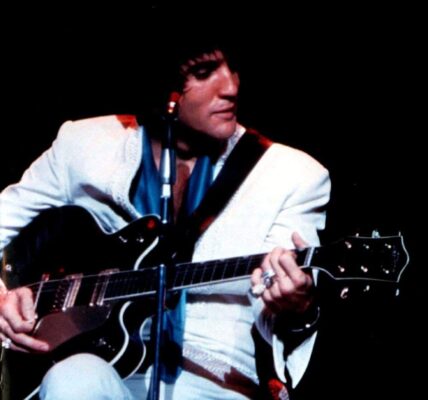“Explore the Magic of Elvis’s ‘When My Blue Moon Turns to Gold Again’ and Its Unforgettable Guitar Riff.”
“When My Blue Moon Turns to Gold Again” is a song that showcases Elvis Presley’s unique ability to blend country and rock and roll into a seamless and captivating performance. Originally written by Wiley Walker and Gene Sullivan in 1940, the song became a hit in the country music scene before Elvis brought it to a broader audience. Elvis’s rendition, released in 1956, is particularly memorable for its emotional depth and musical craftsmanship.

Elvis recorded “When My Blue Moon Turns to Gold Again” during his prolific sessions at RCA’s studios in Nashville, Tennessee. The song was included in his second studio album, “Elvis,” which helped cement his status as a versatile and innovative artist. This album featured a mix of rock and roll, country, and ballads, illustrating Elvis’s wide-ranging talent.
The song’s lyrics tell a story of hope and renewal, a theme that resonated deeply with Elvis’s audience. The “blue moon” symbolizes a period of sadness or loneliness, while its transformation to “gold” represents a time of happiness and fulfillment. This metaphor is beautifully conveyed through Elvis’s soulful voice, which captures the longing and eventual joy expressed in the song. His vocal performance is both powerful and nuanced, allowing listeners to feel the emotional journey the song describes.

Musically, “When My Blue Moon Turns to Gold Again” features a blend of country instrumentation and rock and roll energy. The song opens with a distinctive guitar riff, setting the tone for a piece that is both upbeat and reflective. The use of the steel guitar adds a country flavor, while the rhythm section drives the song forward with a rock and roll beat. This fusion of styles was a hallmark of Elvis’s early career, showcasing his ability to transcend genre boundaries and appeal to a wide audience.
Elvis’s interpretation of the song is notable for its dynamic range. He shifts effortlessly from soft, introspective verses to powerful, soaring choruses, demonstrating his vocal versatility. This dynamic performance keeps the listener engaged and highlights the emotional contrasts within the song. The backing vocals and harmonies also play a significant role, adding depth and richness to the overall sound.

“When My Blue Moon Turns to Gold Again” may not be as well-known as some of Elvis’s biggest hits, but it remains a beloved track among his fans. It exemplifies his skill in interpreting and revitalizing existing songs, infusing them with his distinctive style and emotional intensity. The song is a testament to Elvis’s enduring legacy as a musical innovator and a heartfelt performer.
In conclusion, “When My Blue Moon Turns to Gold Again” is a shining example of Elvis Presley’s ability to blend different musical genres into a cohesive and captivating performance. The song’s emotional depth, combined with Elvis’s powerful vocal delivery and the innovative musical arrangement, make it a standout track in his extensive catalog. It continues to resonate with listeners, offering a glimpse into the timeless appeal of Elvis Presley.
Elvis Aaron Presley, often referred to as the “King of Rock and Roll,” was born on January 8, 1935, in Tupelo, Mississippi, USA. He rose to prominence in the mid-1950s, becoming one of the most iconic and influential figures in the history of popular music. Presley’s musical journey began at an early age when he started singing in church and listening to various genres of music, including gospel, blues, and country. In 1954, he signed a recording contract with Sun Records, where he began his career blending elements of rockabilly, rhythm and blues, and country music. His breakthrough came with the release of his first single, “That’s All Right,” followed by a string of hits such as “Heartbreak Hotel,” “Hound Dog,” and “Jailhouse Rock.” With his charismatic stage presence, distinctive voice, and provocative dance moves, Presley captured the hearts of audiences worldwide, revolutionizing the music industry and popular culture. Presley’s impact extended beyond music; he also found success as an actor, starring in a series of films throughout the 1960s. Despite his commercial success, he faced criticism from some quarters for his crossover into mainstream entertainment and the perceived dilution of his musical authenticity. Throughout his career, Presley struggled with the pressures of fame, leading to personal challenges, including substance abuse and health issues. Despite these obstacles, he remained a beloved figure, revered for his contributions to music and his enduring legacy. Tragically, Elvis Presley passed away on August 16, 1977, at the age of 42, leaving behind a legacy that continues to resonate with generations of fans. He was posthumously inducted into the Rock and Roll Hall of Fame, and his music remains a timeless testament to his enduring talent and cultural impact.




